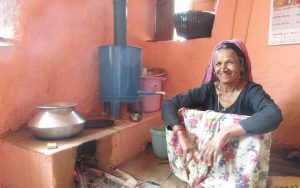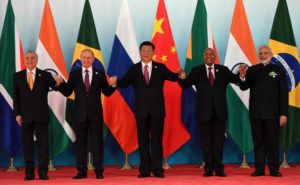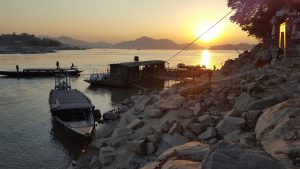Concern for isolated indigenous peoples living in the Amazon is growing over the impacts of the proposed 5,000-kilometre railroad that will connect the Atlantic and Pacific Oceans. The rail corridor, backed by Chinese engineering companies, will cross the territories of some of the most remote indigenous communities as it makes its way through Brazil, Bolivia and Peru. The motive of the project is to lower the costs of shipping grains and other products across the Pacific to China.
“Besides the problem we have with logging and mining (both illegal), the railroad will bring other problems,” said Julio Cusurichi, president of Peru’s Native Federation of the Madre de Dios River and its Tributaries (FENAMAD). He added: “The construction of roads will cut through the reserves where isolated indigenous peoples live.”
Peruvian indigenous communities are racing against time to try to demarcate their territory and ensure they obtain proper titles for land upon which their ancestors have lived for generations. This would be one way to protect against the potential impacts of large infrastructure projects: “Today only about 20% still needs to be demarcated,” Cusurichi told Diálogo Chino.
The Shipibo indigenous leader was in Stockholm recently to speak about demarcation in Peru’s south-eastern Amazonian region of Madre de Dios, where seven different indigenous groups successfully obtained territorial recognition for 37 communities.
In 2002, Cusurichi helped create a 7,600 square-kilometre reserve (around 3,000 square miles) to accommodate indigenous peoples living in voluntary isolation. Five years later, he received the Goldman Environmental Prize, which each year honours human rights and environmental activists.
The highway before the railway
At the summit of the Union of South American Nations (UNASUR) in 2000, the presidents Peru, Bolivia and Brazil signed an agreement to of an agreement to integrate their countries road networks. However, the Initiative for Integration of the Regional Infrastructure of South America (IIRSA), as the project was known, has largely failed to facilitate trade between member countries Peru and Brazil, as it was designed to. According to data from Promperú, the agency to promote Peruvian exports, trade between the two countries grew only US$2.9 million in 2015. Nor has the more than US$2 billion invested in connecting the two countries contributed to a greater diversity of products traded.
In September this year, Peruvian president Pedro Pablo Kuczynski and his Bolivian counterpart Evo Morales reaffirmed their commitment to the transcontinental railway in the southern Peruvian city of Arequipa. Again there was talk of connecting the port of Santos on the southern Brazilian coast with the southern Peruvian port of Ilo, with the line passing through Bolivia. The railroad is set to decrease the time it takes Brazilian goods to reach China by up to 25 days.
The construction of the highway equated to a “bad experience” for indigenous peoples in Peru, according to Cusurichi. The illegal extraction of minerals and wood proliferated, causing increasing environmental damage and worsening living conditions, he said. Furthermore, the road also paved the way for drug traffickers.
In search of allies
In an attempt to ensure legal rights to his land, Cusurichi is seeking allies within Peru’s national ministries. Despite difficulties engaging many of them in dialogue, he has managed to connect with the Ministry of Culture and promote joint actions to protect indigenous peoples living in voluntary isolation on a reservation of 829,000 hectares.
More than half of Peru’s territory is composed of forests, most of which are occupied by indigenous peoples. Ensuring access to lands that are for common use in the Peruvian Amazon would help reduce deforestation and greenhouse gas emissions, and maintain organisations like the Rights and Resources Initiative (RRI).
Many indigenous communities in Madre de Dios live with uncertainty over the legal status of their land. Earlier this month, they participated in a pilot project launched in Sweden by the International Land and Forest Tenure Facility aimed at supporting global indigenous peoples’ claims for territorial recognition. The initiative provides the peoples of Madre de Dios with financial, technical, and legal support as tools for reducing conflicts, promoting human rights, and helping protect the environment.
The project plans to invest around US$10 million per year over the next decade in projects that are intended to guarantee some 40 million hectares of communal land titles. The indigenous peoples of the Peruvian Amazon were one of six pilot projects, along with communities from Indonesia, Mali, Cameroon, Liberia and Sierra Leone, which together claims rights to 1.78 million hectares.
Successful demarcation
“All projects in Madre de Dios must be analysed very carefully because of the existence of the isolated peoples. Any contact could result in the disappearance of an ethnic group,” said Silvana Baldovino, director of the Peruvian Society for Environmental Law (SPDA) who worked in conjunction with FENAMAD.
Baldovino told Diálogo Chino Peru’s national policy to promote investment in investment in natural resources has corresponded with a lowering of environmental standards. Madre de Dios is rich in gold and wood. “The highway promoted an avalanche of growth in mining that has enabled many people to invade a number of areas,” she said. Baldovino suggested that the highway did not generate even a third of the economic activity it was predicted to. However, the environmental impacts were far greater:
“Illegal activities such as deforestation were much more than expected. The impacts from the road were very strong.”
The Tenure Facility’s support for indigenous communities has helped them geo-reference 112,000 hectares of land in Madre de Dios. As a result, three ethnic groups have been able to obtain the demarcation of their land, a total area of 60,000 hectares.
Without land titles, it is very easy for corporations and large projects to evict indigenous people from their areas. “All of a sudden, they might see a truck destroying the home where they have lived for generations. Many indigenous people have experienced this because they did not have a document confirming ownership,” said Nonette Royo, director of the Tenure Facility.
Today, the whole world is watching the Amazon forest, Royo added. She expressed concern with commercial interests and infrastructure projects:
“I hope that the indigenous peoples will strengthen themselves to meet these challenges. We want to support them so they can acquire the titles, and with them they can dialogue and negotiate.”




